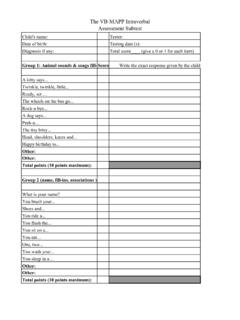Transcription of Vocal Training Basics
1 7/16/2018. Vocal Training Basics August 9, 2018. National autism Conference State College, PA. Heather Forbes, CCC-SLP, BCBA. Amy Foor, CCC-SLP, BCBA. PaTTAN autism Initiative Pennsylvania Training and Technical Assistance Network PaTTAN's Mission The mission of the Pennsylvania Training and Technical Assistance Network (PaTTAN) is to support the efforts and initiatives of the Bureau of Special Education, and to build the capacity of local educational agencies to serve students who receive special education services. 1. 7/16/2018. PDE's Commitment to Least Restrictive Environment (LRE).
2 Our goal for each child is to ensure Individualized Education Program (IEP) teams begin with the general education setting with the use of Supplementary Aids and Services before considering a more restrictive environment. Who are you? 2. 7/16/2018. Agenda Overview of ABA and verbal behavior Overview of vocalizations/ Vocal behavior Assessment of Vocal behavior Assessment analysis Treatment selection and procedures Importance of mand Training Vocal programs by student profile Why are we talking about this? Many learners with autism do not develop Vocal imitation in response to others'.
3 Sounds and words (Esch, Carr & Michael, 2008). Many learners with autism do not acquire speech as their primary form of communication. 3. 7/16/2018. The Value of Vocal Behavior Why focus on Vocal Training ? Humans are evolved to speak Vocal apparatus is always with us (portability). Speech is the most common mode of communication in the general population For adept speakers, it is a very quick and effortless response (efficiency). Vocal Training Challenges Where to start? What assessments to use? How to determine appropriate program? How to select targets? 4. 7/16/2018. Overview ABA AND VERBAL BEHAVIOR.
4 What is ABA? Applied Behavior Analysis (ABA) is a science and a discipline devoted to understanding and improving human behavior. Purpose: to improve socially-significant behavior (examples: language, academic, social, daily living, self care, recreation, and leisure skills). 5. 7/16/2018. ABA and Vocal Training Applied Behavior Analysis (ABA) is the most evidenced - based conceptual framework for autism interventions (National autism Center Standards Project, 2015). Procedures derived from ABA have been successful in Vocal Training . ABCs of ABA. Consider all teaching interactions in relation to behavioral events: A = Antecedent (What happens before behavior).
5 B = Behavior (What person does must be able to observe it and measure it). C = Consequence (What happens after behavior). 6. 7/16/2018. ABCs: examples Antecedent Behavior Consequence Something Look in that See the Event interesting direction happens Need to go out and Turning the knob Door opens seeing a door knob Driving and the Depress brake Car stops traffic light turns pedal red Language as Behavior Behavior is anything a person does that is: Observable (can sense it). Measurable (can count or time it). Communication is observable and measurable ABCs of ABA can be applied to communication 7.
6 7/16/2018. What is Verbal Behavior? Verbal behavior is the analysis of language according to ABCs. Premise: Language is controlled by antecedents and consequences Consequences are delivered by/through other people (social!). Why Verbal Behavior Analysis? Learners with autism present differences in language skills and communicative competency. We can't change something a learner has.. We can alter the environment to change how likely it is that learners will respond to and use language effectively. A behavior analysis of language allows alterations in the environment to promote effective language instruction.
7 8. 7/16/2018. Verbal Behavior Example Antecedent Verbal Consequence Behavior Want water Say water Another person Sign water delivers water Write water . Type water . Exchange a picture of water Point to water . Non-Verbal Behavior Example Antecedent Behavior Consequence Want water Open Get water refrigerator 9. 7/16/2018. Functions of Communication ABCs of language tell us why we say what we say To ask for what we want COOKIE". To label things To answer questions To repeat things we hear Verbal Functions (Verbal Operants). Antecedent Behavior Consequence Mand Motivation Verbal behavior Direct reinforcement (asking) (wants cookie) (says cookie ) (listener gives cookie).
8 Non-specific, social Tact Sensory Stimulus Verbal behavior reinforcement (labeling) (sees or smells cookie) (says cookie ). ( It IS a cookie ). Non-specific, social Verbal Stimulus Intraverbal Verbal behavior reinforcement (someone says "What can (answering) (says cookie ) ( Yes! You CAN eat a you eat? ). cookie. ). Vocal -verbal behavior: Non-specific, social Echoic Verbal Stimulus repeats all or parts of the reinforcement (someone says cookie) antecedent ( Cookie! You said (repeating). (says cookie ) cookie! ). Listener Verbal Stimulus Non-specific Responding (someone says give me a *Non-verbal behavior reinforcement cookie ).
9 * (following (says cookie ) (Listener smiles and says In this case, a cookie must be directions) Thank you! ). present 10. 7/16/2018. Verbal Behavior and Vocal Behavior Why are we talking about this? Analysis of verbal behavior is a critical variable in Vocal Training . We don't just teach speech; we teach speech within a functional context. Vocal versus Verbal WHAT IS Vocal BEHAVIOR? 11. 7/16/2018. What is Vocal Behavior? the production of auditory stimuli resulting from the movements of the muscles of the Vocal apparatus, , the sounds one makes. (Carbone, 2012). Non- Vocal learners may use of other forms of verbal behavior such as signing, writing, typing, picture exchange, and/or speech- generating augmentative devices.
10 Form and Function 12. 7/16/2018. Do Not Give Up on Speech! In teaching learners with autism , we may need to teach non- Vocal forms of verbal behavior at first, such as sign language, if Vocal behavior is not effective. Non- Vocal forms should almost always be viewed as a temporary fix for a Vocal communication deficit. If a learner has few spontaneous vocalizations, does not attempt to echo on request, and/or has poor speech intelligibility, the learner requires a Vocal Training program. Steps in Vocal Training 13. 7/16/2018. Vocal Training ASSESSMENT. Assessment Vocal Training assessment should answer the following questions: Is the learner Is the learner making speech talking?











